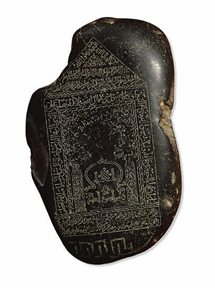
From Tabriz (?), north-west Iran
Dated November 1230 CE
Inscribed stone
Height: 47 cm
Width: 29 cm
Acquisition number: # OA 1990.6-12.1
Image courtesy of the British Museum (copyright reserved)
The Khwarazm-Shahs ruled Khwarazm in the region of north-west of Transoxania from the late eleventh century until the arrival of the conquering Mongols in the mid-thirteenth century. They first served as provincial governors for the Seljuk empire, but gained independence from the Seljuks to rule central and eastern Iran, Transoxiania, and much of Afghanistan as an independent dynasty.1
Khwarazm-Shah Jalal al-Din came to power at an unfortunate time, ascending to the throne just as the Mongol conqueror Chingis Khan was carrying out his invasion of Transoxiania. His father, Khwarazm-Shah cAla' al-Din Muhammad II, did not have the ability to effectively resist the Mongols, and was forced to flee west to die in exile. Jalal al-Din had better luck countering Mongol expeditionary forces, but ultimately he, too, could not contend with Chingis Khan's main invasion force. However, Chingis returned to Mongolia in 1223, giving Jalal al-Din a chance to reconsolidate his power and repair the terrible damage inflicted on his kingdom during the invasion.2 This stone contains an inscription commemorating a military campaign under Jalal al-Din, and is signed by "the stone-cutter Mahmud b. Muhammad," also known as Rashid, a jeweler and a seal-cutter originally from Nishapur in eastern Iran. The stone is believed to mark the occasion of Jalal al-Din's efforts to reestablish control over territories in eastern Turkey, north-west Iran, and Azerbaijan during this period of reconsolidation.3
Khwarazm-Shah Jalal al-Din died in 1231, outliving Chingis Khan by four years (Chingis died in 1227) and prior to the return of the Mongols under Chingis' grandson, Hûlâgû, in the 1250s. This time the defeat of the Khwarazm-Shahs was complete, and their kingdom would remain in the control of the Mongol Il-Khanid dynasty until 1335.
(1) From the web page dedicated to this stone on the British Museum's Compass web site.
(2) Ibid.